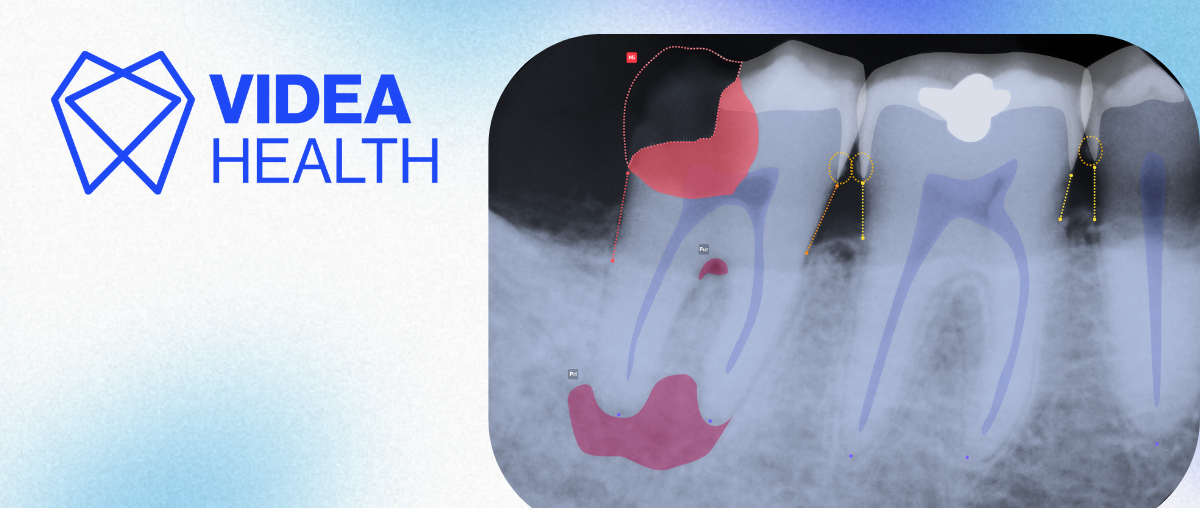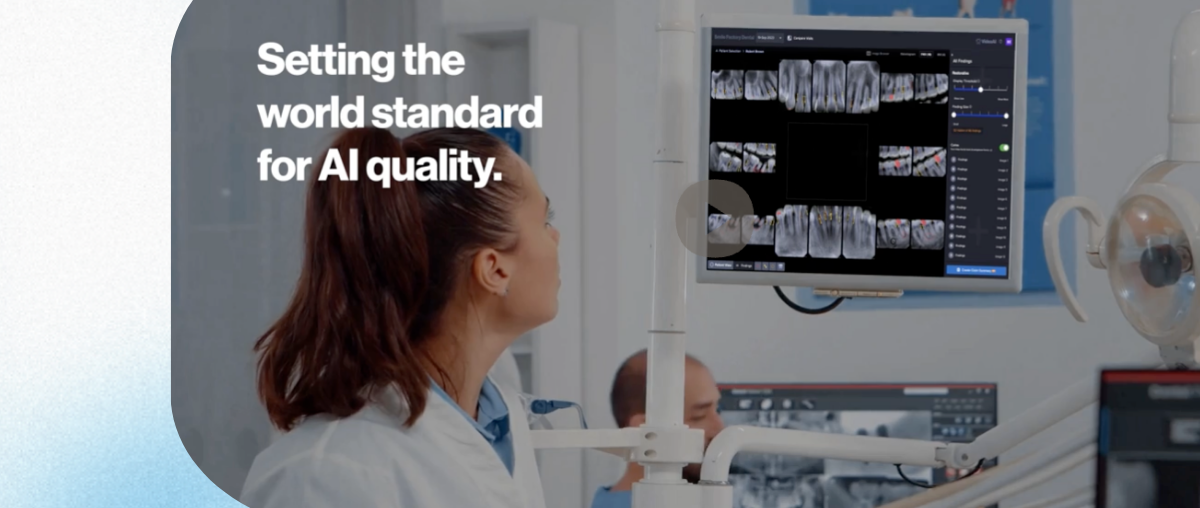
Many fields of healthcare, including radiology, oncology and ophthalmology, are leading the industry by using artificial intelligence (AI) to enhance clinical decision-making and diagnostic capabilities. The field of dentistry is now well on its way to making its mark as an AI innovator.
At VideaHealth, our FDA-cleared AI and software solutions help dentists better analyze patient X-rays to ensure patients receive an accurate diagnosis and enable providers to scale their businesses with increased efficiency and faster reimbursements. Early adopter dentists and DSOs leverage our AI to elevate the standard of care and improve patient outcomes and office efficiency.
As more dental professionals begin implementing AI solutions, it’s important to understand the implications of embracing AI, including accuracy and ethics. Here’s an overview of how AI can improve diagnostic accuracy in dentistry, as well as an explainer of how our team ensures our technology supports our mission to positively impact as many lives as possible.
A brief history of AI in dentistry
From Netflix recommendations to autonomous car image recognition, chances are you’re engaging with AI multiple times each day. However, few people take the time to consider how it works. I’ve written about this in more detail in DentalTown, but to simplify things, AI and humans are not so different when it comes to certain tasks: We review available information and use what we know to infer something about a situation or subject. For example, when a human sees a picture of a squirrel on a tree branch, we quickly identify the animal’s brown fur, bushy tail and small eyes. Between these indicative characteristics and its location in a tree, we easily identify the subject as a squirrel. AI algorithms are able to learn to recognize these features and come to the same conclusion, but with a major advantage: It can do so at scale.
AI in medical imaging is similar. All dental pathologies have representative characteristics that occur in typical locations. Dentists spend years learning to identify these characteristics. They must review hundreds or thousands of examples to fully understand the nuances by which healthy teeth are distinguished from diseased teeth. They occasionally get things wrong during their training but eventually learn to distinguish finer details through repeated feedback from peers, textbooks and other examples. AI has the ability to process and analyze massive datasets in mere moments.
At VideaHealth, we craft AI to learn these nuances in a similar repeated fashion, at scale. Our computer vision algorithms review tens of thousands of X-ray examples from our AI factory to learn the features that distinguish the characteristics of healthy and unhealthy teeth. Our AI can analyze more data than any individual dentist could over the course of their entire career. Videa Caries Assist enables dentists and their teams to augment their expertise with information culled from a diverse set of patient data from thousands of dentists to generate data trends, including pathology detection and treatment recommendations. It is a powerful tool that can be used by both new and experienced dentists to enhance and support expertise and decision-making.
The importance of evaluating AI accuracy
When asked a question, both humans and AI algorithms are evaluated relative to a “true” answer. The gold standard of truth in medicine is the diagnosis corroborated by tangible evidence– did the biopsy reveal cancer? Did the oral exam reveal real tooth decay? When a dentist or AI is reviewing X-rays, they don’t have this information yet. Rather, they are looking for the characteristic dark spots indicative of possible tooth decay that signal the need for further review.
Experienced dentists have seen thousands of examples of dark spots on X-rays that end up corresponding to real tooth decay. As such, a panel of dentists is able to use their combined expertise to mark “true” regions that they believe, to the best of their knowledge and from the information available, to be likely to be real tooth decay and thus to be worth oral review.
In trials, we evaluate the performance of dentists with and without AI assistance relative to the truth defined by the expert panel on a given set of X-rays. We measure how often the true regions were identified and how often regions were identified that were not seen by the expert panel. The identification of true regions is sometimes called the “true positive rate,” while the inability to identify those true regions is called the “false-negative rate.” These are effectively synonymous. The identification of regions not seen by the expert panel is sometimes called the “false positive rate.” Our goal was to increase the amount of true positives identified by dentists without increasing the number of false positives – and we succeeded. Indeed, we noted that dentists aided by Videa Caries Assist actually reported fewer false positives. That this human + AI team improved both performance and consistency is no accident– we designed our algorithm to balance both.
AI ethics in dentistry
As dentists know, the clinical importance of finding true regions can’t be understated: Patient care is dependent on timely, accurate and complete identification of all instances of disease. Likewise, the clinical importance of not introducing more false regions is equally important: False identifications may needlessly scare patients and lead to unnecessary treatment plans. Furthermore, these false identifications slow dentists down, as they’ll need to remember and crosscheck more regions during an oral review that didn’t need any review at all.
At VideaHealth, our biggest priority as a team is ensuring that our solution is effective across diverse patient populations and helps dentists deliver the most accurate diagnoses. This paves the way for more appropriate dental treatment recommendations and the opportunity for dentists to foster deeper levels of trust with patients. Our commitment to transparency and ethics served as a North Star when honing our AI algorithm.
Before starting an FDA clinical study, one has to “lock the algorithm in” and decide how eager the algorithm should be in making predictions. Aggressive predictive algorithms find many instances of disease, inflating the perceived value, but also predict a plethora of misleading or incorrect regions. This puts a high burden on the dentist and may lead to overtreatment of the patient. We opted to make Videa Caries Assist more conservative. It is our moral duty to our patients to do so. For weaker algorithms, this would come at the cost of severely reduced detection capability, but our machine learning team was capable of still delivering best-in-class caries detection results.
At VideaHealth, our team believes it is our ethical responsibility to ensure our AI improves both sensitivity and specificity detection capabilities. Our FDA trial proves our technology accomplishes this. We’re very proud of what we achieved.
How does this relate to Videa’s groundbreaking Videa Caries Assist platform?
As part of our FDA trial, we found that our AI helped dentists identify more true caries regions while simultaneously reducing their identification of false regions. This is the gold standard for assistive AI algorithms: Simultaneously increasing a dentist's performance while increasing their consistency is a powerful result.
AI-aided dentists had a 30.8% relative increase in diagnostic sensitivity with a 15% reduction in the average number of false positives per image compared to dentists not using Videa’s AI. Our FDA study also showed that the VideaHealth AI helps dentists regardless of their experience level. Designed to be deployed at the same time the dentist reviews the X-rays for the first time, it requires no additional steps to their workflow. Our solution provides a true, concurrent read and seamlessly integrates with the leading dental practice software.
AI-enhanced dentistry with VideaHealth means more accurate diagnoses and treatment recommendations, fewer errors, more effective preventative care and lower costs for patients. Furthermore, it opens the door for dentists to become frontrunners in holistically improving human health. From reducing disparities in tooth decay to supporting populations with unmet oral health needs and associated chronic diseases, this is a critical step toward meaningful health system transformation.
With powerful AI technology and forward-thinking partners, we’re on our way toward revolutionizing the dental industry. We invite you to join us on this journey. Contact us today to learn more about how you can start leveraging the power of AI with VideaHealth.

.png)


